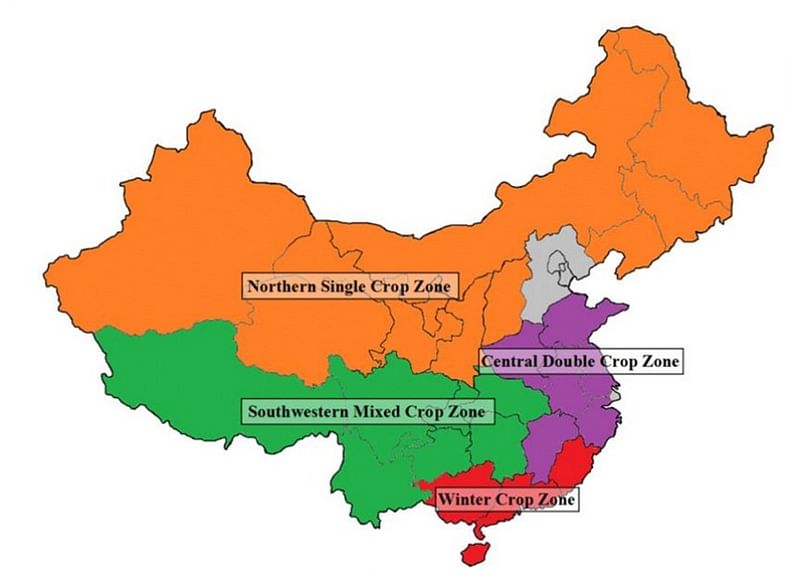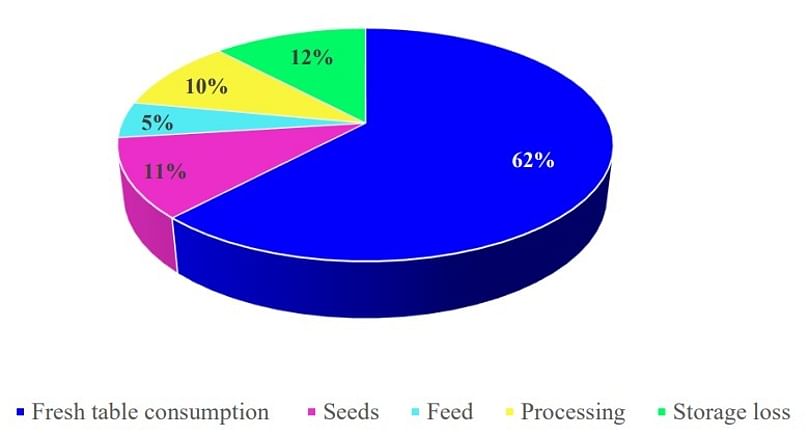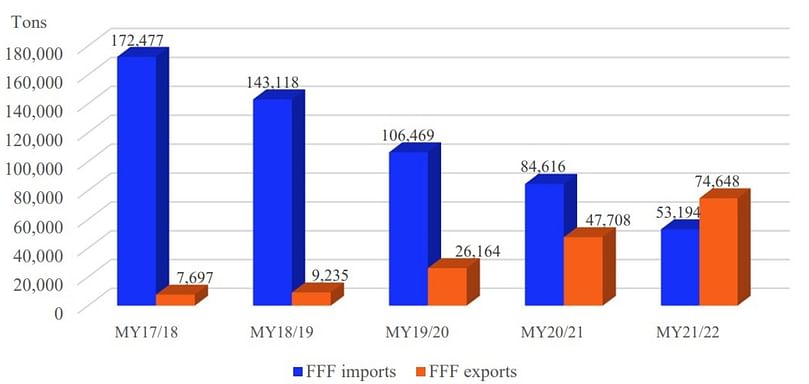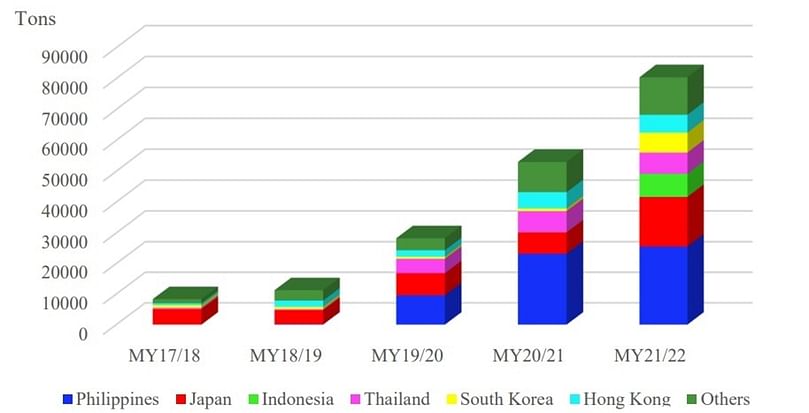China: Average Wholesale Prices of Fresh Potatoes (RMB/kg) (Figure 1)
China: Frozen French Fry Exports Exceed Imports

Fresh potato production for MY 2022/23 (September to August) is forecast at 93 million metric tons (MMT), a small decrease from the estimated 95 MMT produced in MY 2021/22 owing to reduced acreage.
According to industry sources, the potato planting area decreased in the northern single crop zone (see Image 1 below), especially in northeast China, due to government incentives and price supports intended to boost soybean production.
Please refer to GAIN Report Oilseeds and Products Annual and Oilseeds and Products Update for more information on China’s soybean production expansion. Low prices (see Figure 1 below) at the start of the harvest season in the Southwestern, Central and Winter crop zones, which account for half of China’s fresh potato production, also contributed to the reduction in planted area for MY 2022/23.
According to China’s 2022 Agricultural Outlook Report on Potatoes the average wholesale price of fresh potatoes in 2021 was 2.3 yuan/kg (USD 0.15/lb.), a 12.7 percent decline from 2020, and the lowest level in six years.
According to industry sources, the quality of fresh potatoes in MY 2022/23 is expected to be lower than normal. Excessive rainfall in northern provinces has resulted in high water content in potatoes. For example, local media reported that average precipitation in Shandong province in June 2022 was 138 percent higher than normal.
In Northeast China, especially in Inner Mongolia, small fluctuations in daytime and nighttime temperatures during the growing season will also affect crop yields and the quality of fresh potatoes in MY 2022/23.
The 2022 China Agricultural Outlook Report predicts potato acreage and yield will increase over the next ten years by an average of 0.5 and 1.3 percent a year, respectively. However, such growth will be difficult to accomplish as China has prioritized grain and oilseed production and placed additional restrictions on arable land use. These factors will limit expansion in potato production acreage.
The top six potato producing provinces in the People’s Republic of China (PRC) are Sichuan, Guizhou, Gansu, Inner, Mongolia, Hebei, Yunnan. These provinces are located in the Northern Single Crop Zone and the Southwestern Mixed Crop Zone.
These specific provinces account for over 60 percent of total fresh potato production. There are four major potato growing zones in China: 1) the northern single crop zone; 2) the southwestern mixed crop zone; 3) the central double crop zone; and 4) the winter crop zone.

China: Map of Potato Zones (Image 1)
1)The Northern Single Crop Zone – This region accounts for 50 percent of China’s total potato area. The potatoes produced in this area are used for seed potatoes, direct consumption, and processing.
Potatoes in this zone are usually planted between late April and early May and harvested from September through October. This zone includes Hebei, Heilongjiang, Jilin, Liaoning, Inner Mongolia, Gansu, Xinjiang, Qinghai, Ningxia, Shanxi, and Shaanxi provinces.
2)The Southwestern Mixed Crop Zone – This region accounts for 35 percent of China’s total potato acreage. The potatoes produced in this area are mainly for direct consumption.
Potatoes in this zone are usually planted September through November and harvested from February through April. This zone includes Sichuan, Guizhou, Yunnan, Tibet, Chongqing, and parts of Hunan and Hubei provinces.
3)The Central Double Crop Zone – This region accounts for 10 percent of total acreage. Spring potatoes are planted in February through March and harvested during May or June.
Autumn potatoes are planted July through August and harvested in October and November. The potatoes produced in this area are mainly for export and direct consumption. This zone includes Jiangxi, Jiangsu, Zhejiang, Anhui, Shandong, and Henan provinces.
4)The Winter Crop Zone – This region accounts for 5 percent of total acreage. Potatoes in this zone are planted October through November and harvested in February and March. The potatoes produced in this area are mainly for export and direct consumption. This zone includes Guangdong, Fujian, Guangxi, and Hainan provinces.

China: Potato Planting and Harvest Seasons (Image 2)
Frozen French Fries
The PRC’s MY 2022/23 FFF production is estimated at 400,000 MT, a slight decrease from 410,000 MT in MY 2021/22 on lower fresh potato quality.
According to industry sources, most FFF processors expanded contracted potato acreage in early 2022 to meet increased domestic demand for FFF; however, the expansion in acreage will be offset by the lower quality of fresh potatoes. FFF domestic production uses less than 1 percent of total fresh potato production.
According to industry reports, four new FFF production lines will be put into production from July to September 2023. The total production capacity of the new lines is expected to reach an additional 400,000 MT, doubling overall production capacity.
The significant increase in production capacity is to meet growing domestic demand as well as growing export demand. Over the last few years, FFF imports have dropped sharply (see Trade section) due to the COVID-19 pandemic and logistics disruptions.
The PRC’s FFF producers have expanded domestic production capacity as imports declined and domestic demand increased (see Consumption section below). Meanwhile, some major FFF producers have plans to increase exports to Southeast Asian countries affected by logistics disruptions and supply chain issues.
Consumption
The PRC’s fresh potato consumption is basically in line with its production, as trade volume is negligible compared to production. Fresh table consumption accounts for over 60 percent of total fresh potato consumption (see figure 2 below).
According to China’s Agricultural Outlook Report, the distribution of potato consumption across these various sectors is expected to remain relatively stable over the next 10 years.

China: Forecast Fresh Potato Consumption in 2022 (Figure 2) (Courtesy: China Agricultural Outlook Report 2022)
Industry contacts have shared that FFF consumption will continue to increase as urbanization and fast-food restaurants expand. According to media reports, Yum China Holdings (a major operator of quick service restaurants) opened more than 1,200 new stores in China in 2021 and expects to open 1,000-1,200 new stores in 2022.
McDonald's goal of reaching 4,500 total stores in the PRC by the end of 2022 was achieved ahead of schedule in the first quarter of 2022. The PRC’s domestic fast-food stores are also developing rapidly.
Wallace (a local fast food chain brand in China) has more than 20,000 stores across the country, with rapid expansion in thirdand fourth-tier cities1 due to competitive prices.
U.S. Potatoes for Processing
U.S. potatoes for processing (i.e., chipping potatoes) exports are expected to face continuing challenges shipping to China in MY 2022/23.
Although U.S. potatoes for processing acquired market access through a phytosanitary protocol that would allow registered shippers in Idaho, Oregon, and Washington to ship to China, commercial market entry has yet to be realized due to a requirement that import and processing facilities in China be registered with the PRC’s competent authority as handling "major commodities" prior to the issuance of import permits.
U.S. potatoes for processing have been successfully imported on two occasions as sample shipments to trade shows in China.
Trade
In MY 2021/22, the PRC imported 53,194 tons of FFF and exported 74,648 tons of FFF, with FFF exports exceeding imports for the first time (Figure 3).

China’s FFF Exports and Imports (Figure 3) (Courtesy:Trade Data Monitor (China Customs data))
Imports
China’s MY 2022/23 FFF (HS Code: 20041000) imports are forecast at 50,000 MT, six percent lower than the 53,194 MT imported in MY 2021/22. As increased domestic production and logistical challenges hurt imports.
In MY 2021/22, China imported 53,194 tons of FFF, a 37 percent decrease from MY 2020/21, mostly due to logistical disruptions. In the case of FFF, contacts shared that international logistics did not improve in 2022 as expected but have continued to deteriorate.
According to industry sources, with increased domestic production many buyers have switched to purchasing locally produced FFF to avoid delivery delays and other challenges associated with importing cold chain food products.
Industry contacts indicate that China’s FFF imports will not return to previous highs even if international logistics return to normal. In the future, imported FFF are expected to mainly supply high-end markets (including export markets, such as Japan), or special types of FFF that cannot be produced in China.
Cold chain products, including FFF imports, face continued challenges within China. Importers should be aware of China’s COVID-19 testing and disinfection measures (see GAIN report CH2022-0022). These measures will likely cause additional costs and delays.
The United States continued to be the largest FFF exporter to China in MY 2021/22, accounting for 53 percent of China’s total FFF imports. The next largest exporters, Belgium, Turkey, Argentina, and the Netherlands together accounted for 43 percent of China’s FFF imports in MY 2021/22.
Exports
Driven by strong demand from neighboring countries, China’s MY 2022/23 FFF exports are estimated at 84,000 MT, a 12 percent increase from 74,648 MT in MY 2021/22.
According to China Customs data, China’s FFF exports in MY 2021/22 totaled 74,648 tons, a 56 percent increase from MY 2020/21, mainly driven by the strong demand from the Philippines, Japan, Indonesia, Thailand, and South Korea.
These countries previously imported FFF from the United States and Europe. However, disruptions in logistics and short FFF supply from the United States have led buyers to favor closer suppliers.
Industry sources expect that China’s domestic FFF production will increase significantly with the four new FFF processing lines, which are expected to be in full operation by MY 2023/24. China is expected to be a major FFF supplier in Southeast Asia.
At present, China’s FFF is price competitive with U.S. FFF. According to the Philippine’s Statistics Authority (Trade Data Monitor), the Philippine’s average FFF import price from China was $922/MT in the first six months of 2022; while it was $1,128/MT from the United States.

China: FFF Exports (MY 2017/18- MY 2021/22) (Figure 4) (Courtesy:Trade Data Monitor (Chinese Customs data)







